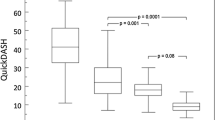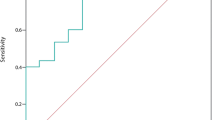Abstract
The Disabilities of the Arm, Shoulder and Hand (DASH) is a standardized patient-based outcome measure, which assesses integrated upper-extremity disorders. The objectives of this study were to investigate subjective outcome after upper-extremity surgeries for the patients with rheumatoid arthritis (RA) using the DASH questionnaire (Japanese version) and to investigate the influence of disease activity on the surgical outcome using the Disease Activity Score (DAS) 28-CRP(4). Approximately 127 surgical procedures for the upper extremities in 127 patients with RA were recruited in this study. Surgeries were performed in 4 shoulders, 35 elbows, 60 wrists and 28 hands. The DASH score (disability/symptom score) was investigated just before surgery and at follow-up. The mean follow-up period after the surgery was 15 months on average (range, 6 to 24 months). The preoperative DASH score (disability/symptom score) 50 ± 23 (mean ± SD) decreased significantly to 38 ± 23 at the follow-up (n = 127, p < 0.01). Standardized response mean and effect size revealed a medium effect of −0.6 and −0.5. Patients with various degrees of disease activity improved and the improvements per se were comparable of preoperative disease activity and postoperative response to medical treatment. A favorable subjective outcome of rheumatoid upper-extremity surgeries can be anticipated under the good control of disease activity.


Similar content being viewed by others
References
Henmi S, Yonenobu K, Masatomi T et al (2006) A biomechanical study of activities of daily living using neck and upper limbs with an optical three-dimensional motion analysis system. Mod Rheumatol 16:289–293
Hudak PL, Amadio PC, Bombardier C (1996) Development of an upper extremity outcome measure: the DASH (disabilities of the arm, shoulder and hand). Am J Int Med 29:602–608
Beaton DE, Katz JN, Fossel AH et al (2001) Measuring the whole or the parts? Validity, reliability, and responsiveness of the disabilities of the arm, shoulder and hand outcome measure in different region of the upper extremity. J Hand Ther 14:128–146
Imaeda T, Toh S, Nakao Y, Nishida J et al (2005) Validation of the Japanese society for surgery of the hand version of the disability of the arm, shoulder, and hand questionnaire. J Orthop Sci 10:535–539
van der Heijde DMFM, van’t Hof MA, van Riel PLCM et al (1990) Judging disease activity in clinical practice in rheumatoid arthritis: first step in the development of a disease activity score. Ann Rheum Dis 49:916–920
Prevoo MLL, van’t Hof MA, Kuper HH et al (1995) Modified disease activity scores that include twenty-eight-joint counts. Development and validation in a prospective longitudinal study of patients with rheumatoid arthritis. Arthritis Rheum 38:44–48
Darrach W (1913) Partial excision of lower shaft of ulna for deformity following Colles’ fracture. Ann Surg 57:764–765
Sauvé L, Nouvelle KM (1936) Technique de traitement chirurgical de luxations rècidivantes isolees de l’extrèmitè infèrieure du cubitus. J Chir 47:589–594
Swanson AB (1972) Flexible implant arthroplasty for arthritic finger joints: rationale, technique, and results of treatment. J Bone Joint Surg 54A:435–455
SooHoo NF, McDonald AP, Seiler JG III et al (2002) Evaluation of the construct validity of the DASH questionnaire by correlation to the SF-36. J Hand Surg 27A:537–541
Offenbächer M, Ewert T, Sangha O et al (2003) Validation of a German version of the disabilities of arm, shoulder and hand questionnaire (DASH-G). Z Rheumatol 62:168–177
Hunsaker FG, Cioffi DA, Amadio PC et al (2002) The American Academy of Orthopaedic Surgeons outcomes instrument. Normative values from the general population. J Bone Joint Surg 84A:208–215
Jester A, Harth A, Germann G (2005) Measuring levels of upper-extremity in employed adults using the DASH questionnaire. J Hand Surg 30A:1074–1082
Gummesson C, Atroshi I, Ekdahl C (2003) The disabilities of the arm, shoulder and hand (DASH) outcome questionnaire: longitudinal validity and measuring self-rated health change after surgery. BMC Musculoskelet Disord 4:11
van Gestel AM, Prevoo MLL, van’t Hof MA et al (1996) Development and validation of the European league against rheumatism response criteria for rheumatoid arthritis. Comparison with the preliminary American Collage of Rheumatology and the World Health organization/International League Against Rheumatism Criteria. Arthritis Rheum 39:34–40
Husted JA, Cook RJ, Farewell VT et al (2000) Methods for assessing responsiveness: a critical review and recommendation. J Clin Epidemiol 53:459–568
Hildebrand KA, Patterson SD, Regan WD et al (2000) Functional outcome of semiconstrained total elbow arthroplasty. J Bone Joint Surg 82A:1379–1386
Angst F, John M, Pap G, Mannion AF et al (2005) Comprehensive assessment of clinical outcome and quality of life after total elbow arthroplasty. Arthritis Rheum 53:73–82
Angst F, Pap G, Mannion AF et al (2004) Comprehensive assessment of clinical outcome and quality of life after total shouder arthroplasty: usefulness and validity of subjective outcome measures. Arthritis Rheum 51:819–828
Felderhoff J, Wiemer P, Dronsella J et al (1999) The operative therapy of distal unstable radius fractures with dorsal and volar plates. A retrospective study with respect to the DASH-score system. Orthopäde 28:853–863
Westphal T, Piatek S, Schubert S et al (2002) Reliability and validity of the upper limb DASH questionnaire in patients with distal radius fractures. Z orthop Ihre Grenzgeb 140:447–451
Kotsis SV, Chung KC (2005) Responsiveness of the Michigan hand outcomes questionnaire and the disabilities of the arm, shoulder and hand questionnaire in carpal tunnel surgery. J Hand Surg 30A:81–86
Murphy DM, Khoury JG, Imbriglia JE et al (2003) Comparison of arthroplasty and arthrodesis for the rheumatoid wrist. J Hand Surg 28A:570–576
Adey L, Ring D, Jupiter JB (2005) Health status after total wrist arthrodesis for posttraumatic arthritis. J Hand Surg 30A:932–936
Nyszkiewicz R, Neumann R (2001) Experiences with the Eaton-Littler procedure for ligament reconstruction for the painful thumb carpometacarpal joint. Handchir Mikrochir Plast Chir 33:424–430
Angst F, John M, Goldhahn J et al (2005) Comprehensive assessment of clinical outcome and quality of life after resection interposition arthroplasty of the thumb saddle joint. Arthritis Rheum 53:205–213
Chiari-Grisar C, Koller U, Stamm TA et al (2006) Performance of the disabilities of the arm, shoulder and hand outcome questionnaire and the Moberg picking up test in patients with finger joint arthroplasty. Arch Phys Med Rehabil 87:203–206
Smith-Petersen MN, Aufranc OE, Larson CB (1943) Useful surgical procedures for rheumatoid arthritis involving joints of the upper extremity. Arch Surg 46:764–770
Gschwend N (1980) Objective nature of the operations. In: Gschwend N (ed) Surgical treatment of rheumatoid arthritis. W.B.Saunders, Philadelphia, pp 18–24
Baumgartner H, Dovrak J, Grob D et al (1995) Staging of surgery in the upper limb. In: Baumgartner H, Dovrak J, Grob D et al (eds) Rheumatoid arthritis, Current trends in diagnostics, conservative treatment, and surgical reconstruction. Georg Thieme Verlag, Stuttgart, pp 161–168
Author information
Authors and Affiliations
Corresponding author
Rights and permissions
About this article
Cite this article
Ishikawa, H., Murasawa, A., Nakazono, K. et al. The patient-based outcome of upper-extremity surgeries using the DASH questionnaire and the effect of disease activity of the patients with rheumatoid arthritis. Clin Rheumatol 27, 967–973 (2008). https://doi.org/10.1007/s10067-007-0830-8
Received:
Revised:
Accepted:
Published:
Issue Date:
DOI: https://doi.org/10.1007/s10067-007-0830-8




